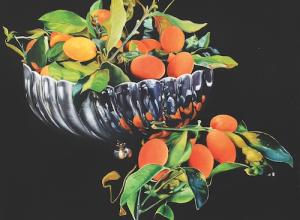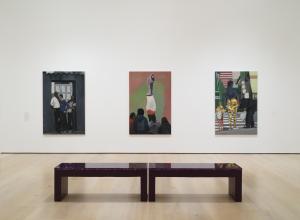
Djanira da Motta e Silva, Bahian Market, 1956. Oil on canvas. Private collection, Salvador, Bahia
February is Black History Month in the United States, which makes this a great time to appreciate the amazing contributions African American artists and other members of the Black diaspora have made to art, culture and social justice. From painting, sculpture, photography, collage, textile art and cinema, these 10 outstanding exhibitions and installations, that you can visit in February, have something to offer everyone.

The first Black woman to represent the US at the Venice Biennale in 2022, the incomparable auto-ethnographic sculptor and installation artist Simone Leigh’s survey is currently on view at the Hirshhorn Museum and Sculpture Garden through March 3, 2024. Simone Leigh includes signature pieces from the Biennale–including the monumental bronze Satellite (2022), which was previously installed at the American Pavilion entrance—as well as three new bronze sculptures created specifically for this exhibition. Leigh’s work frequently melds the female form with shapes from traditional African arts, crafts and architecture, centering the Black female experience within the context of history and self-determination. Next, this survey will travel to the Los Angeles County Museum of Art.
Image: Simone Leigh, Cupboard (detail), 2022. Bronze and gold, 88 1/2 × 85 × 45 in (225 × 216 × 114.3 cm).

Deeply committed to social justice, multimedia artist Tomashi Jackson creates immersive work utilizing painting, printmaking, video, photography, fiber, and sculpture, that scrutinizes systemic inequities and celebrates empowerment. The first retrospective to bring together her various bodies of work, Tomashi Jackson: Across the Universe, kicks off on February 10 at Philadelphia's Institute of Contemporary Art. Placing the various genres Jackson has explored over the last eight years in conversation with each other, the exhibition illustrates how Jackson’s approach to color and conceptual layering translates from painting to sculpture to video.
Another exhibition worth catching at the ICA is Entryways: Nontsikelelo Mutiti, for which Zimbabwean-born visual artist and educator, Nontsikelelo Mutiti, reimagines the ICA's windows combining African hair braiding patterns and hair clips with symbols often found in ironwork–patterns initially created by enslaved West African blacksmiths that have become a shared diasporic visual language. This installation marks the inaugural project for a new series commissioning artists to activate the ICA’s façade.
Image: Tomashi Jackson, Chattahoochee River Camouflage (Derek) (1970 Home Values Map), 2018.

Comrade Sisters: Women of the Black Panther Party at the Museum of Fine Arts, in Boston, showcases the powerful women of the Black Panther Party–an important engine for civil rights and social change in the 1960’s and 70’s. Contrary to popular belief, the women in the organization, who were known as “comrade sisters,” comprised over sixty-five percent of the party’s membership. Twenty-seven photographs by award-winning white photojournalist, Stephen Shames, some featuring party leaders such as Ericka Huggins and Kathleen Cleaver, capture these women’s everyday existence and crucial contributions to the Panthers’ community outreach programs across the United States. A social activist, Shames became the party’s official photographer after meeting its cofounder Bobby Seale at an anti-war demonstration in 1965, documenting their activities through 1973.
Image: Oakland, California: Kathleen Cleaver; Communications Secretary and first female member of the Party’s decision-making Central Committee, talks with Black Panthers from Los Angeles who came to the *Free Huey* rally in DeFremery Park (named by the Panthers Bobby Hutton Park) in West Oakland, July 28, 1968. Stephen Shames (American, born 1947). Photograph, archival pigment print. Gift of Lizbeth and George Krupp.

Afro-Atlantic Histories at the Dallas Museum of Art is a powerful exhibition exploring the diverse visual cultures of the Afro-Atlantic. Including work from the 17th century to the present, the exhibition juxtaposes historical works by European artists with later works by artists of the Black Diaspora, reframing, reflecting on and reimagining the brutal history and ongoing impact of the TransAtlantic slave trade, while celebrating the vitality of Afro-Atlantic history and culture. https://afro-atlantic-histories.dma.org/p/1
Image above: Aaron Douglas, Into Bondage, 1936, oil on canvas, National Gallery of Art, Washington, D.C., Corcoran Collection (museum purchase and partial gift from Thurlow Evans Tibbs, Jr., the Evans‐Tibbs Collection).

A monumental permanent public installation by the Whitney Museum in collaboration with Hudson River Park, David Hammons: Day's End was inspired by an ephemeral 1975 installation with the same name by Gordon Matta-Clark. Matta-Clark cut five openings into the Pier 52 shed that formerly occupied the site along the Hudson River, to create a peaceful enclosure filled with changing light. Hammons' Day’s End, installed along the Hudson River at the southern edge of Gansevoort Peninsula, directly across from the Whitney Museum, is a tubular steel outline of the original shed, creating a stunning open structure that feels both architectural and sculptural, allowing viewers to experience space in a new way.
Image: David Hammons, Day’s End, 2014 - 2021. Stainless steel and precast concrete, overall: 52 ft high, 325 ft long, 65 ft wide.

Kehinde Wiley: An Archaeology of Silence at Houston’s Museum of Fine Arts continues artist Kehinde Wiley’s interrogation and reframing of Western European portraiture conventions. With this exhibition, which is on view through May 27, Wiley tackles through painting and sculpture the iconography of repose and sacrifice, depicting contemporary Black and Brown people in attitudes traditionally used for heroes, martyrs, and saints. Through these beautifully monumental, elegiac paintings and sculpture, Wiley confronts the silence that still surrounds the systemic violence and injustice faced by Black people.
Image: Kehinde Wiley, Femme, Piquée par un Serpent (Mamadou Gueye), 2022, oil on canvas, Fondation Louis Vuitton, Paris.

On view February 10–July 7, 2024, at the Brooklyn Museum, Giants: Art from the Dean Collection of Swizz Beatz and Alicia Keys includes work by major names in the Black Diasporic art world, including Gordon Parks, Jean-Michel Basquiat, Lorna Simpson and Kehinde Wiley. Producer and musician Swizz Beatz (Kasseem Dean) and Alicia Keys, respectively, believe in “artists supporting artists,” and have amassed an eclectic and impressive collection of world-class art encompassing everything from photography and abstraction to portraiture and installation art. Giants is the first major exhibition from their collection.
Image: Ebony G. Patterson (born Kingston, Jamaica, 1981). . . . they were just hanging out . . . you know . . . talking about . . . ( . . . when they grow up . . .), 2016. Beads, appliqués, fabric, glitter, buttons, costume jewelry, trimming, rhinestones, glue, digital prints, 90 × 224 in.(228.6 × 569 cm). The Dean Collection, courtesy of Swizz Beatz and Alicia Keys.

Internationally renowned visual artist Mark Bradford’s Pickett’s Charge is a massive ongoing installation series of eight abstract collaged paintings–each over forty-five feet long–encircling the entire Third Level galleries of the Hirshhorn Museum. Inspired by French artist Paul Philippoteaux’s nineteenth-century cyclorama depicting the final charge of the Battle of Gettysburg, Bradford's installation, which is on view through 2025, combines colored paper, copies of historic Gettysburg imagery and segments of rope into stratified layers of color and texture. Cutting, tearing, and scraping the layers, Bradford revealed inner complexities, creating a nuanced visual experience infused with history.
Image: Installation view of Mark Bradford: Pickett’s Charge at the Hirshhorn Museum and Sculpture Garden, 2017. Courtesy of the artist and Hauser & Wirth. Photo: Cathy Carver.

The first major museum exhibition dedicated to Black collage art, Multiplicity: Blackness in Contemporary American Collage, which opens at the Museum of Fine Arts, Houston on February 18, includes works by a wide variety of contemporary artists, including Wangechi Mutu, Mark Bradford, and Lovie Olivia. Working with a variety of media, from traditional paper, fabric, and repurposed materials to digital and video collages, the artists in this show examine culture, gender, history, beauty, identity, and power.
Image: Tschabalala Self, Sprewell, 2020. Fabric, thread, painted canvas, silk, jeans, painted newsprint, stamp, photographic transfer on paper, and acrylic on canvas. Solomon R. Guggenheim Museum, New York, gift.

The Detroit Institute of Arts’ groundbreaking exhibition, Regeneration: Black Cinema 1898-1971, highlights the often overlooked and undervalued trailblazing contributions of African American artists to the world of cinema. On view through June, Regeneration features nearly 200 historical items–including photographs, costumes, props, posters and newsreels–exhibited alongside installation and conceptional art by major contemporary artists. In conjunction with Regeneration, the Detroit Film Theatre created a specially-curated film series, with over twenty film events centered on Black cinema.
Image: The Nicholas Brothers in a scene from Stormy Weather (1943), from left, Fayard Nicholas and Harold Nicholas. Photographic print, gelatin silver.
Megan D Robinson
Megan D Robinson writes for Art & Object and the Iowa Source.























